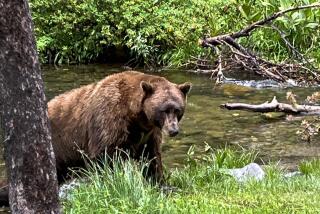Grizzlies no safer than average bears
After more than 30 years of strict federal protection, the Yellowstone population of grizzly bears is being removed from the endangered species list by the Bush administration.
Formidable remnants of the wild frontier, the Yellowstone grizzlies, living in and around the national park, have rebounded from fewer than 200 animals in 1975, when they were listed as a threatened species, to about 600 today.
“There is simply no way to overstate what an amazing accomplishment this is,” Deputy Interior Secretary Lynn Scarlett said Thursday of the grizzly’s comeback.
The move means that for the first time in three decades, grizzlies could soon be hunted on a limited basis in some parts of the Yellowstone region -- outside the park -- where the largest population of grizzlies in the lower 48 states roams across thousands of square miles of mostly federal wild lands.
Were it not for the sanctuary of the park, the Yellowstone bears undoubtedly would have vanished, victims of hunting and clashes with humans who unwittingly attracted them with open garbage dumps and then took a rifle out to settle the encounter.
Although environmentalists agreed the bear numbers have climbed to a heartening degree, some criticized the Yellowstone delisting, warning that climate change is reducing a vital food source and human population growth is increasing the chances of lethal run-ins.
“We’re going to take action to fight this,” said Louisa Willcox, Wild Bears Project manager for the Natural Resources Defense Council. “It’s ill conceived and premature.”
According to federal wildlife officials, there are 1,100 to 1,400 of the iconic creatures in the lower 48 states. Four populations in northern Montana and in parts of Idaho and Washington will remain protected under the Endangered Species Act.
There are about 30,000 grizzlies in Alaska and another 25,000 in Canada.
The Yellowstone grizzly bear joins a short list of high-profile species, including the bald eagle and the gray wolf, that the federal government is moving to take off the list.
The key to the bears’ success is all the money and attention they’ve gotten, said Chris Servheen, grizzly bear recovery coordinator for the Fish and Wildlife Service.
“The act works,” he said. “I’m lucky to work on a species that is big and flashy, but a lot of people don’t have that luxury.”
Wildlife managers have spent $24 million over the last 25 years on grizzly recovery.
“It’s really important to have this as a success story,” Servheen said. “I’m regretting groups [for whom] it’s never good enough. Some people always want more.”
The image of an angry grizzly standing taller than a man -- a fierce, untamable force of nature -- runs though Western lore.
There were more than 50,000 of them in the lower 48 states in 1800. By the mid-1970s, they had been hounded and hunted to near-extinction, their numbers reduced to fewer than 1,000.
They rebounded in the Yellowstone region because the killing stopped. Hunting was banned. Open garbage pits were closed, reducing the human encounters that had so often left the grizzly dead.
Sloppy food storage in campgrounds was curtailed. The Forest Service ended sheep grazing in prime bear habitat, reducing livestock losses that enraged ranchers and led to illegal bear killings.
“People do things differently now than when the bear was first listed,” Servheen said.
The move, which will be published March 29 in the Federal Register and take effect a month after that, will turn over management of Yellowstone grizzlies living outside the park to Wyoming, Montana and Idaho. Bears inside the park will continue to be managed by the National Park Service.
The states have signaled that they may allow hunting of the grizzlies outside the park, but that would have to occur within strict mortality limits established by federal biologists.
“Hunting will in no way ever threaten the future of the Yellowstone grizzly,” Servheen said, predicting that only a handful of hunting licenses would be issued.
Under the action, a 9,200-square-mile conservation area will be established that encompasses the habitat of most of the bears. Within that area, activities that could hurt the population -- such as new campsite development or livestock grazing -- will be restricted by federal land managers.
The grizzly numbers will also be watched, so if they start to dip, federal scientists can recommend steps to stop the slide. “There are checks and balances built into the management system to respond,” Servheen said.
Willcox called the delisting a disappointment, saying Yellowstone grizzlies are facing increasing pressure.
“There are more and more homes and more subdivisions and sprawl,” she said. “The more human-bear interaction, the more conflicts and the more dead bears there are.”
Moreover, she warned, climate-change models show sharp drops in an important grizzly food source, whitebark pine.
Craig Kenworthy, conservation director of the Greater Yellowstone Coalition, said that although his group would like to see the bears taken off the list, he was concerned there would not be adequate monitoring of the population or its food sources. He also worried that a change in Forest Service planning rules would make it harder to gauge the effect of activities that could harm bear habitat.
“It will be possible to be nibbled to death by ducks,” he said.
More to Read
Sign up for Essential California
The most important California stories and recommendations in your inbox every morning.
You may occasionally receive promotional content from the Los Angeles Times.










